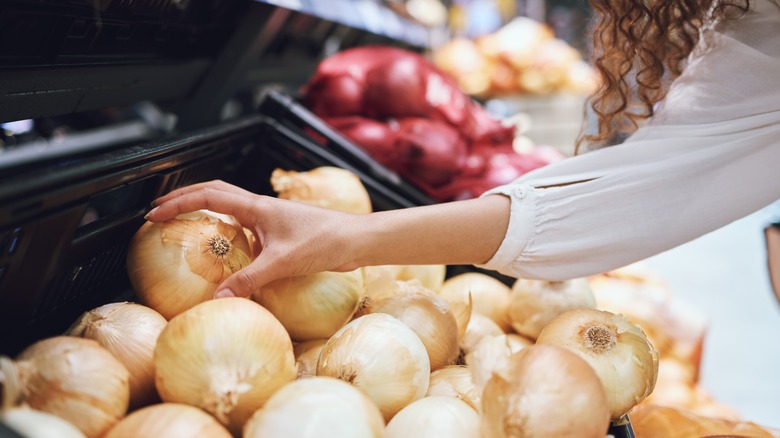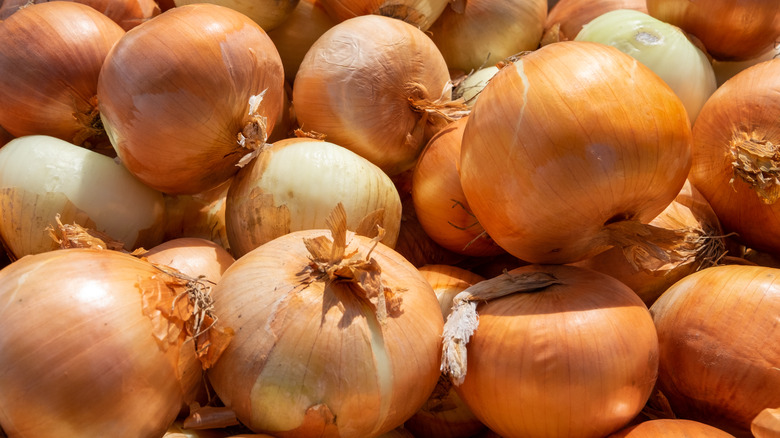Spanish Vs Sweet Onions: What's The Difference?
Your grocery store's produce section can soon turn perplexing as you marvel at the piles and piles of onions surrounding you. Red onions are distinctive enough to set aside, but how do you know which of the various beige-toned onions are the best to buy? Maybe you have a specific recipe you're shopping for, or maybe you're doing a pantry restock and just want to have onions on hand for cooking throughout the week.
Don't mistake the Spanish onion for just any ordinary yellow onion – it tastes milder and gentler in flavor while having a more bulbous shape. And don't mistake a Spanish onion for a sweet one, as sweet onions are a unique variety. Though mildly sweet, a Spanish onion has a broader range of usage in cooking than sweet onions, but it is even larger than its yellow onion cousins. Although Spanish onions have a bit of sweetness, they're not as sweet as sweet onions, which are a category all on their own. Sweet onions are flatter, softer, and have a taste unlike any other onion variety, being truly, well, sweet. Sweet onions are also certainly the favored choice to consume fresh or raw.
The lowdown on Spanish onions
While yellow onions are usually the go-to for sauteeing, Spanish onions are the type of yellow onion that's mild enough to eat raw if desired. These delicate characteristics, such as the lack of aggressive sharpness present in most onions, are partially due to how they're grown.
Spanish onions are grown in low-sulfur soil, contributing to the lack of astringent taste and the slight hint of sweetness. So, if you're looking for subtlety in your cooking instead of an overpowering onion flavor, Spanish onions are the way to go. They're great when lightly sauteed and used as an aromatic or when cooked over a longer period of time, like when incorporated into a soup or stew. Spanish onions are also a fantastic choice for taking caramelized onions up a notch, as their inherent mild flavor is turned delicately and deliciously sweet during the caramelization process.
All about sweet onions
How are sweet onions so naturally sweet on their own? It's all in how they grow. They naturally have a higher water content, and some sweet onions, like the coveted, sweet Vidalia onion grown in Vidalia, Georgia, are seasonal and extra sweet because of the naturally low-sulfur soil they're grown in. Sulfur is the main factor contributing to onion pungency, so this lack of sulfur is the main reason why they turn out so sweet. So don't miss out on the opportunity to try sweet onions raw. Sweet onions add a perfect crunch and delectable sweetness when thinly sliced and topped on a salad or layered into a sandwich. And there's a reason sweet onions are also the most popular choice for making crispy batter-fried onion rings.
It's important to remember that because they're smaller and softer with thinner skins, sweet onions must be kept refrigerated. They can perish quicker than other onion varieties you can just leave on the counter. To make them last even longer, store them in the fridge in a paper bag or layer newspaper in your crisper drawer to help soak up extra moisture. So, although sweet onions and Spanish onions both have delicate, sweet qualities and look a bit alike, their subtle differences are worth paying attention to, so you make sure you use each kind to its fullest potential.


